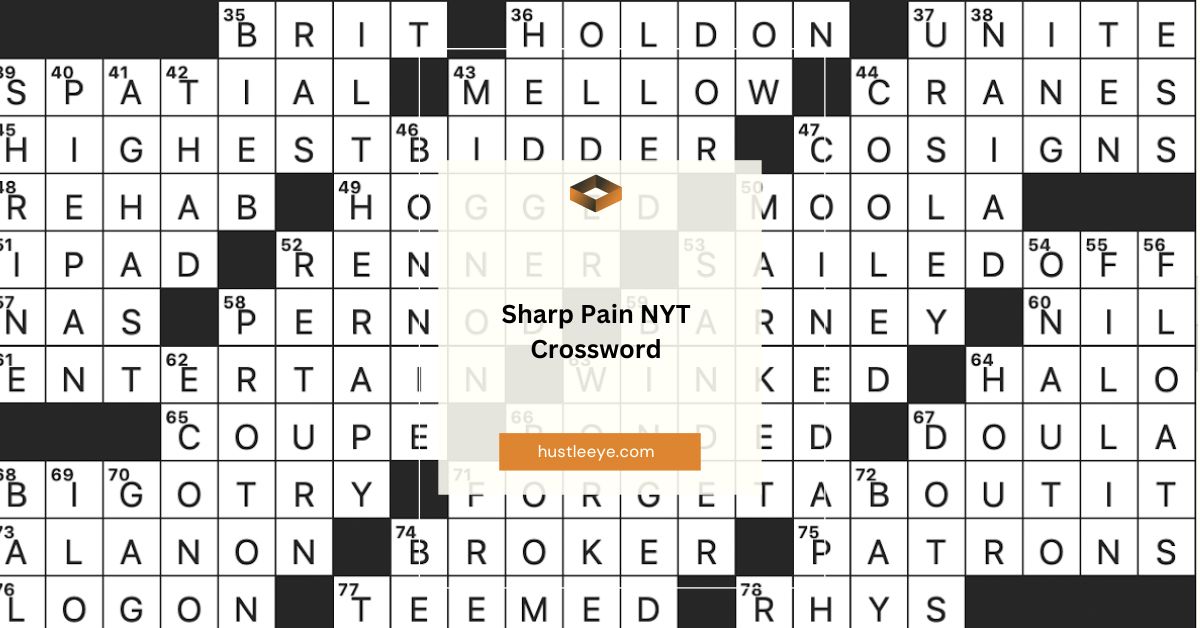Crossword puzzles are an intriguing intellectual challenge that millions of people around the world enjoy solving daily. Among the plethora of clues that the New York Times (NYT) crossword offers, one particular clue—“sharp pain”—has caught the attention of many. This clue has stumped solvers and pushed them to think creatively and critically. In this article, we will explore the “sharp pain NYT crossword” clue in great detail, providing insight, strategies, and in-depth analysis to help solvers understand and tackle this and similar crossword challenges.
Our goal is to create an easy-to-understand, thorough, and highly informative guide that surpasses existing content and aids readers in becoming more proficient at solving crosswords. We’ll cover everything from the solution to this specific clue to broader solving strategies, common pitfalls, and the mental benefits of crossword puzzles.
Whether you’re a beginner or an experienced solver, this guide will equip you with the tools and knowledge to improve your crossword-solving skills.
Table of Contents
What Is the “Sharp Pain NYT Crossword” Clue?
The “sharp pain NYT crossword” clue is one of many that appears in the NYT crossword puzzles, known for their wit, challenge, and clever wordplay. The specific clue “sharp pain” was featured in the NYT crossword on May 8, 2024, and has since sparked interest among solvers.
1. The Solution to the “Sharp Pain” Clue:
The answer to the “sharp pain” NYT crossword clue is “stabbing.” This word effectively describes a sudden and intense sensation of pain, which fits the criteria for “sharp pain” perfectly.
2. Why Is “Stabbing” the Correct Answer?:
- Literal Meaning: The term “stabbing” vividly describes a sensation that feels like a sharp object piercing the body. It’s an acute, localized pain that occurs suddenly, which is what makes it an ideal solution for the clue “sharp pain.”
- Crossword Puzzle Conventions: “Stabbing” is a common word used in crosswords to describe a sharp and intense pain, making it a familiar term for seasoned solvers. It also fits the typical NYT crossword structure and the number of letters required by the puzzle.
Read More: The Visionary Path of Rauf Avvalzade: A Deep Dive into the Tech Luminary
Why Is the “Sharp Pain” Clue Challenging?
The challenge of solving the “sharp pain” clue stems from several factors that make crosswords both intriguing and difficult. Here’s why this clue may trip up solvers:
1. Ambiguity of Pain Descriptions:
Pain can be described in various ways—sharp, dull, throbbing, aching, burning—and each type of pain could have several possible answers. For example, “sharp pain” might conjure up words like pierce, prick, jab, or cut, depending on the puzzle’s context.
2. Contextual Clues:
Crosswords are not solved in isolation. The words that surround the clue in the puzzle provide critical context. Solvers must consider these adjacent words to ensure their solution fits properly. For example, if the clue to the right of “sharp pain” is “actor’s line” and the answer is “cue,” the letter “C” could be the first letter in the word for “sharp pain,” guiding you toward “cut” or “cramp” as a possible solution.
3. Word Length and Grid Constraints:
The number of letters in the answer must fit the grid of the crossword puzzle. This means that even if a solver thinks of a suitable word, it may not be the correct answer if it doesn’t fit the allocated number of spaces in the grid.
Read More: GLNG Game Acronym: An In-Depth Exploration
Similar Crossword Clues for Pain:
Crossword clues related to pain often appear in puzzles, and knowing common answers can help solvers tackle future puzzles. Here are some examples of clues similar to “sharp pain” and their solutions:
1. Dull Pain:
- Answer: Ache
- Explanation: “Ache” describes a persistent, less intense type of pain compared to “sharp pain.” It usually refers to a generalized discomfort.
2. Piercing Pain:
- Answer: Agony
- Explanation: “Agony” refers to severe pain, but it’s often used in a broader sense to describe extreme physical or emotional suffering.
3. Burning Sensation:
- Answer: Smart
- Explanation: In some contexts, the word “smart” is used to describe a sharp, stinging pain, like when you get a cut or a burn.
4. Throbbing Pain:
- Answer: Pulse
- Explanation: “Pulse” refers to rhythmic pain that feels like it comes in waves, often associated with headaches or other conditions.
Read More: Understanding the T-King XAC-A8913 Diagram: A Comprehensive Visual and Functional Breakdown
Effective Strategies for Solving the NYT Crossword:
Solving crossword puzzles, especially challenging ones like those in the NYT, requires a combination of knowledge, creativity, and logic. Here are some tried-and-true strategies to help you tackle crossword clues related to pain and other abstract concepts.
1. Contextual Understanding:
Always consider the context provided by the surrounding clues and answers. The words already placed in the grid can offer valuable hints about the correct answer to a given clue.
2. Think About Synonyms:
When solving clues like “sharp pain,” think about different ways to express the idea. For example, words like jab, pierce, prick, twinge, cramp, or cut could all describe sharp pain depending on the puzzle’s context.
3. Break the Clue Down:
If a clue seems difficult, break it down word by word. For example, in the clue “sharp pain,” focus on the idea of something being “sharp” and consider how that could relate to different kinds of pain.
4. Practice Regularly:
The best way to improve at crosswords is to practice regularly. The more puzzles you solve, the better you’ll get at recognizing common clues, patterns, and answers. Over time, you’ll develop an intuition for crossword conventions.
5. Use Crossword Solvers:
If you get stuck, consider using online crossword solver tools to help generate possible answers based on the clue and the number of letters. These tools can be especially helpful for obscure or tricky clues.
Read More: 14.415 AED to USD: A Comprehensive Guide for Accurate Currency Conversion
The Cognitive Benefits of Solving Crossword Puzzles:
Crossword puzzles are not just fun; they offer significant cognitive benefits. Regularly solving puzzles like the NYT crossword can improve various mental skills, making them an excellent brain-training exercise. Here are some of the key benefits:
1. Vocabulary Expansion:
Crosswords introduce solvers to new words, phrases, and terminology, expanding their vocabulary over time. You’ll find yourself using words you may not have encountered before in everyday life.
2. Improved Problem-Solving Skills:
Crosswords require logic, critical thinking, and creativity to solve. The process of deciphering clues and finding words that fit into the puzzle grid sharpens your problem-solving abilities.
3. Memory Enhancement:
Solving crossword puzzles exercises both short-term and long-term memory. You have to recall words, meanings, and phrases and apply them to the context of the puzzle, which helps boost your mental retention.
4. Pattern Recognition:
Crosswords help improve pattern recognition skills. The more you solve, the better you become at identifying common word patterns and letter combinations, which can be applied to other types of puzzles and mental challenges.
Read More: SSM Smart Square Login: A Comprehensive Guide (2024 Edition)
FAQs About the “Sharp Pain” NYT Crossword Clue:
1. What Is the Answer to the “Sharp Pain” NYT Crossword Clue?
The answer to the “sharp pain” clue in the NYT crossword is “stabbing.” This term accurately describes a sudden, intense type of pain.
2. Why Is “Stabbing” the Correct Answer?
“Stabbing” fits the clue’s description of sharp pain because it refers to a sudden and acute sensation that feels like being pierced by something sharp.
3. Are There Other Common Clues Related to Pain in Crosswords?
Yes, crosswords often feature clues related to pain, such as “dull pain” (answer: ache), “piercing pain” (answer: agony), and “burning sensation” (answer: smart).
4. What Should I Do If I Get Stuck on a Crossword Puzzle?
If you get stuck, try taking a break and returning to the puzzle with fresh eyes. You can also use online crossword solver tools or ask for help from crossword communities.
5. How Can I Improve My Crossword-Solving Skills?
Regular practice, familiarizing yourself with common clues and answers, using crossword solver tools, and learning to recognize patterns in puzzles are all effective ways to improve your crossword-solving skills.
Conclusion: Mastering the “Sharp Pain” NYT Crossword Clue
The “sharp pain NYT crossword” clue is an excellent example of how crossword puzzles challenge solvers to think critically and creatively. The answer “stabbing” encapsulates the intensity and suddenness of sharp pain, making it a perfect fit for the clue.
By applying the strategies and insights from this guide, you can tackle not only the “sharp pain” clue but also similar crossword challenges in the future. Crosswords are a rewarding mental exercise that improves cognitive skills, expands your vocabulary, and provides endless entertainment. Keep practicing, stay curious, and enjoy the world of crossword puzzles.


